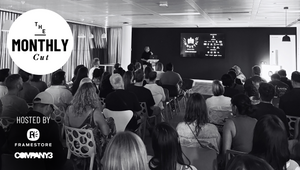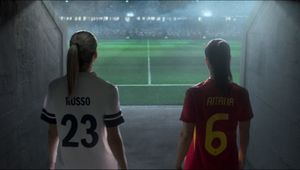
Framestore Adds Some Magic to 'Fantastic Beasts and Where to Find Them'

Framestore Creative Director Christian Manz took the reigns as overall VFX Supervisor on Warner Bros.' Fantastic Beasts and Where to Find Them, alongside long-time collaborator Tim Burke. Reuniting the studio with David Heyman and David Yates, Framestore had an integral part to play in the overall creative process from pre-production onwards. Pablo Grillo headed up development of all of the key Beasts as the film's Animation Director, whilst concepts and creatures were developed by Framestore’s Art Department.
Having previously contributed to every film within the Harry Potter franchise, Beasts was a great chance for Framestore to once more delve into the wizarding world of J.K. Rowling. Some five years after the release of The Deathly Hallows, the team found that it wasn’t only technology that had dramatically changed within the creation of these films; the process has become increasingly collaborative, touching on multiple departments whose skills would have influence on the final script.
Pablo Grillo, Animation Director, was introduced to the film very early on, personally recruited to the project by Producer David Heyman. Says Pablo: ‘J.K. Rowling’s wonderful script was filled with characters and creatures. Having seen how animation is such a big part of the process in a film like this, we decided that it was important to be involved from the concept stage onwards, instead of the animation and VFX being passed on like a baton from one set of artists to the other.'
A group of Framestore animators jumped on board to provide their expertise from earliest pre production, helping to drive the creative process behind the creature development. Working with Framestore’s Art Department as well as the filmmakers, it was a process of testing what these creatures could bring to the table. ‘Of course there were creatures we tested that didn’t make the film; but it was about the process of whittling it down, and that was the real joy of working on this project,' adds Animator Andras Ormos. ‘We had such a creative input that stretched beyond the postproduction stage; deciding what worked and what wouldn't in the overall film.’

Above: The Occamy
The team worked on animation tests in previsualisation to get the creatures moving, looking and acting the right way, making it easier for the filmmakers to visualise the beasts and how they would fit into the scenes. ‘I would say that this has been the most collaborative film that I’ve worked on,’ says overall VFX Supervisor Christian Manz. ‘Framestore was involved from the very beginning, and had a huge hand in the creative process.’
Once the creatures passed the animation tests, Framestore artists were an integral part of the 50-strong team who worked on postvis for important scenes, including that in the bank. ‘This scene is driven by the relationship between Newt and the Niffler; there was a history we had to get across, the fact that the Niffler was notorious for escaping and pick-pocketing, and that Newt was going through the motions in trying to catch him. They understood each other; there were little looks, a language in their movement,' explains Ormos. Framestore worked with The Third Floor to postvis key scenes such as this, to quickly insert animations within the live action footage before passing onto the post teams, including those at Framestore, who worked to finalise the sequences.
The Niffler

The Niffler escapes Newt’s suitcase to cause its own kind of mayhem throughout the film. First introduced to Potter fans by Hagrid in Harry Potter and the Goblet of Fire, the Niffler is described by J.K. Rowling as ‘a long-snouted, burrowing creature native to Britain with a penchant for anything shiny.’ ‘The team worked on maybe a hundred iterations of the Niffler,’ says Animator Andras Ormos. ‘I tested about 3 or 4 versions then we slowly started incorporating different ideas around how the character would fit in its scenes.’
Grillo looked at a host of references including platypus and moles: ‘creatures that carried charm, had the spirit and the attitude that we felt could fit the character. Riffing on these forms, we could start designing movement sketches. How does it move around a bank and how does it navigate around people? Out of that we could start designing how he can wreak havoc in the most comical way.’
Once the team had the design and postvis in place, the assets was passed to Framestore’s Montrėal team for animation. ‘To make the creature stand out from its New York City backdrop, we added colour around the eyes, top of the head and tips of the feathers,' says Stephane Nazé, VFX Supervisor. A puppet of the creature was used on-set to show the correct trajectory, lighting and scale, also helping the actors to interact with the beast. ‘The slow motion shot of the Niffler flying through the diamond district, with a nice 360-degree exploration of the space, is my favourite shot,' adds Nazé. ‘Until that point the audience are trying to catch glimpses of the Niffler – he's moving quickly, and always scuttling out of shot. When he’s spinning through the air, we get to really enjoy him.’
Similar to a magpie in its love for sparkling objects, the Niffler can steal large amounts of treasure at a time and conceal the goods in its pouch – very similar to how Hermione’s bag works in the Harry Potter films, enhanced with its Undetectable Extension charm. Framestore used its proprietary Flesh and Flex rigging toolkit (developed for David Yates’ The Legend of Tarzan) to develop an authentic muscle and skin simulation during the shots in which the Niffler magically ‘pockets’ its loot.
Gnarlack: The Gangster Goblin

‘Gnarlack is one of the best digital humanoids yet,' says Pablo Grillo, ‘And a testament to the talent that we have here in Framestore.’ A cigar-chewing, wise-cracking goblin who stalks around his speakeasy, the character of Gnarlack was heavily influenced by the actor Ron Perlman. Perlman was shot on set in Leavesden for a series of motion-capture sessions with the Capture Lab team. ‘Ron has a strong feature set: his eyes are hooded, so it made tracking around the eye especially difficult,' explains Richard Graham, Capture Lab Studio Manager. ‘Plus his character was constantly smoking a cigar and drinking whisky, so we had to work around that.’ Perlman wore a Vicon Cara 3D facial motion capture headset, surrounded by four witness cameras.
More cameras were needed to capture the subtle details of his face. ‘To assist the facial reconstruction of the character, we had him sit before 98 cameras for a facial coding shape session,' explains Andy Kind, VFX Supervisor. This allowed the team to sculpt the face directly in 3D, refining the performance in keyframe animation.
Within the Blind Pig speakeasy scene, Framestore also worked on a goblin singer (Aretha Ayeh, who performed on set and Emmi who provided the vocals) as well as a medley of magical creatures. ‘We created CG characters for the giants, elves and band ensemble,' adds Kind. ‘Then we gave them crazy instruments including a sousaphone/trumpet concoction. Pablo and the team then developed the keyframe animation.’
Erumpent

J.K. Rowling describes the Erumpent as ‘a huge African magical beast resembling a rhinoceros.’ A stunning piece of keyframe animation, the Erumpent presented the team with a big challenge. Says Manz: 'There was also complex stuff from a technical standpoint, like this sort of liquid sack on the Erumpent's forehead that made her slightly more unusual than a normal creature. That had to move and have internal lighting.'
The filmmakers used a huge puppet controlled by puppeteers from the stage show War Horse to interact with the actors, as the beast skidded across a frozen pond in Central Park. The puppet was then replaced by Framestore’s CG asset. In a key scene within Central Park Framestore integrated the excited Erumpent, animating the creature bursting from the pond using dynamic simulations of shattering ice, explosive snow and water effects.
‘The set for the park and lake were quite contained,’ explains Manz. ‘There was an awful lot of digital environment as well as the beast itself. David fell in love with the postvis for this scene, led by Pablo. It was great to be able to play with shots and offer up suggestions for the edit. It was a very organic way of filmmaking.'
Pickett the Bowtruckle

There are several Bowtruckle creatures in the film, but Newt is especially fond of Pickett, carrying him in his top pocket as he searches for the escaped beasts. In the original book, J.K. Rowling describes the Bowtruckle as ‘immensely difficult to spot, being a hand-sized, insect-eating tree dweller with long sharp fingers (two on each hand), brown eyes, and a general appearance of a flat-faced little stickman made of bark and twigs.'
The filmmakers had around 200 versions of concept artwork for Pickett, before landing on the perfect design in a process that spanned two months. Puppeteers, using a rod operated Bowtruckle, helped with Pickett’s interactions on set, giving some great reference material for Framestore during the keyframe animation, and something for Eddie Redmayne to interact with.
‘We were told that Picket moved too slowly at first, and that he appeared too old. We played with the speed, but kept his movements graceful', says Manz. ‘He didn’t really have any facial animation, but he does blow a raspberry at one point. In the end we added more shots to get Pickett’s story to go through, as everyone just loved him.’
Framestore also worked on an array of supporting VFX, including an environment inside Newt’s suitcase, as well as bulging to the exterior as the magical beasts moved around. Framestore also worked on a variety of set extensions of 1920s New York.
Framestore’s expertise in virtual reality was also drawn upon for the magical launch of J.K. Rowling’s Fantastic Beasts and Where To Find Them for the new Google Daydream. Framestore VR Studio created an experience for the headset in which users wave a wand, explore the magic of Newt’s case, meet the beasts, cast spells and solve puzzles, utilising film and photoreal assets to build a deeply immersive world.
You can find out more about the film and Framestore's work by clicking here.















